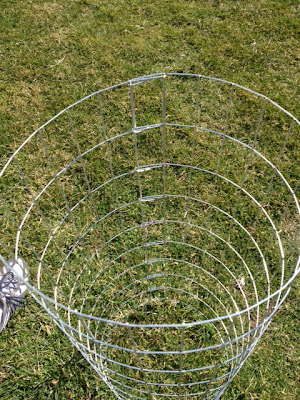Remember all those little tomato seeds you planted?
Little seedlings:
Before you know it, they'll be in your garden and be huge tomato plants like this:
This picture was take summer of 2011 before the tomato plants fully developed. See those tiny yellow flowers on them? They are tomatoes-to-be.
To support these plants, you'll need cages.
Now, you can buy cages, but (1) the can be expensive, especially if you're buying several and (2) they can be flimsy, which means those cute little seedlings will grow into big plants that will bully flimsy tomato cages.
This defeats the purpose of tomato cages, which is to support the tomato plant and keep it off the ground, where it can be at risk for too much moisture (which will cause disease and distress) or pests (like the naughty mole that ate my tomatoes last year because I didn't have them in cages).
So, let's talk about making cages to support your tomatoes.
First, is to get the materials you'll need.
We used a wire garden fencing that you can get at any home improvement store or garden center. Our was about four feet tall.
Word of advice: USE GLOVES FOR WORKING WITH THIS WIRE!
My wonderful teen son did this for me (while I took the pictures) and you'll notice he's wearing his gloves.
Unroll the wire to about four to five feet in length. Then, use a pair of wire cutters or snipping shears to cut the wire. You'll want to cut it so that you have pieces that you can later use to fold back. Yes, these will look like little spikes and will ACT like little spikes if you're not careful.
You can see that the length is about 4 feet or so.
This is somewhat of a blurry pic, but you may be able to tell how the spike is now looped back in on itself, around the solid piece.
When you're finished, you'll have a circle of wired fencing, perfect for a tomato plant.
Hmmmm...I'll have to see what I can do about that!










No comments:
Post a Comment